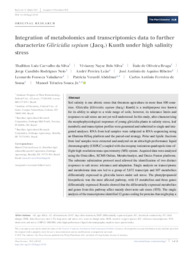Integration of metabolomics and transcriptomics data to further characterize Gliricidia sepium (Jacq.) Kunth under high salinity stress.
Integration of metabolomics and transcriptomics data to further characterize Gliricidia sepium (Jacq.) Kunth under high salinity stress.
Author(s): SILVA, T. L. C. da; SILVA, V. N. B.; BRAGA, I. de O.; RODRIGUES NETO, J. C.; LEAO, A. P.; RIBEIRO, J. A. de A.; VALADARES, L. F.; ABDELNUR, P. V.; SOUSA, C. A. F. de; SOUZA JUNIOR, M. T.
Summary: Soil salinity is one abiotic stress that threatens agriculture in more than 100 countries. Gliricidia [Gliricidia sepium (Jacq.) Kunth] is a multipurpose tree known for its ability to adapt to a wide range of soils; however, its tolerance limits and responses to salt stress are not yet well understood. In this study, after characterizing the morphophysiological responses of young gliricidia plants to salinity stress, leaf metabolic and transcription profiles were generated and submitted to single and integrated analyses. RNA from leaf samples were subjected to RNA sequencing using an Illumina HiSeq platform and the paired-end strategy. Polar and lipidic fractions from leaf samples were extracted and analyzed on an ultra-high-performance liquid chromatography (UHPLC) coupled with electrospray ionization quadrupole time-offlight high-resolution mass spectrometry (MS) system. Acquired data were analyzed using the OmicsBox, XCMS Online, MetaboAnalyst, and Omics Fusion platforms. The substrate salinization protocol used allowed the identification of two distinct responses to salt stress: tolerance and adaptation. Single analysis on transcriptome and metabolome data sets led to a group of 5,672 transcripts and 107 metabolites differentially expressed in gliricidia leaves under salt stress. The phenylpropanoid biosynthesis was the most affected pathway, with 15 metabolites and three genes differentially expressed. Results showed that the differentially expressed metabolites and genes from this pathway affect mainly short-term salt stress (STS). The single analysis of the transcriptome identified 12 genes coding for proteins that might play a role in gliricidia response at both STS and long-termsalt stress (LTS). Further studies are needed to reveal the mechanisms behind the adaptation response.
Publication year: 2021
Types of publication: Journal article
Unit: Embrapa Agroenergy
Keywords: Adaptation, Salinization protocol
Observation
Some of Embrapa's publications are published as ePub files. To read them, use or download one of the following free software options to your computer or mobile device. Android: Google Play Books; IOS: iBooks; Windows and Linux: Calibre.
Access other publications
Access the Agricultural Research Database (BDPA) to consult Embrapa's full library collection and records.
Visit Embrapa Bookstore to purchase books and other publications sold by Embrapa.

